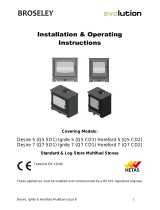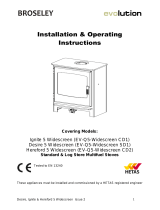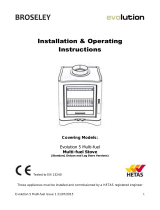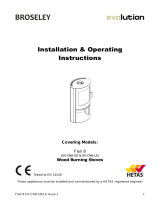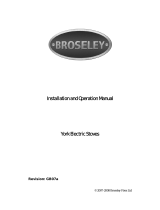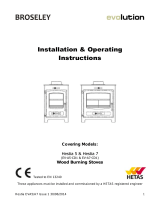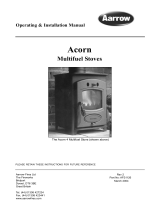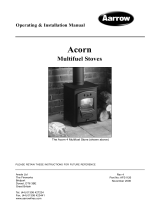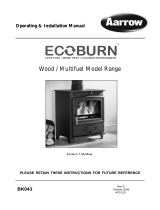Page is loading ...

JUL13GB Issue 2 1
Installation & Operating
Instructions
Covering Model:
Winchester,
Multifuel Stove
Tested to EN 13240
These appliances must be installed and commissioned by a HETAS registered engineer

JUL13GB Issue 2 2
Contents
Introduction 3
Packing List 3
Health & Safety 4
Specifications 5
Dimensions 6
Hearth Requirements & Clearances 7
Chimney Requirements 8
Combustion Air Requirements 9
Assembly 10
Stove Operation
Controls Layout 11
Controls Explained 12
Air wash System 12
Ash Pan 12
Recommended Fuels 13
Lighting the Stove
Kindling Stage 14
Burning Wood & Burning Coal 15
Warning Notes 16
Maintenance
Ash Removal 17
Chimney Fires 17
Chimney Sweeping 17
General Stove Cleaning 17
Glass Cleaning 17
Annual Stove Service 17
Trouble-shooting 18
Commissioning Form 19
Spare Parts 20
EC Declaration 21
Annual Service Record 22
Warranty 23

JUL13GB Issue 2 3
Introduction
May we take this opportunity to thank you for choosing one of our cast iron, multifuel
stoves.
The term multifuel refers to the fact that the appliance is capable of burning either wood
logs or coal (that is suitable for closed appliances). Both of these fuels have very different
air requirements in order for them to burn correctly, therefore the air controls need to be
operated differently depending on the fuel being burned (see section “Stove Operation”).
See the section “Lighting the Stove” for further details. After reading this document, if there
is anything you are unsure about, please contact your dealer or our Technical Support
Department.
These instructions cover the basic principles to ensure the satisfactory installation of the
stove, although detail may need slight modification to suit particular local site conditions. In
all cases the installation must comply with current Building Regulations, Local Authority
Byelaws and other specifications or regulations as they affect the installation of the stove.
It should be noted that the Building Regulations requirements may be met by adopting the
relevant recommendations given in British Standards BS 8303 and BS EN 15287-1 2007 +
A1 2010 as an alternative means to achieve an equivalent level of performance to that
obtained following the guidance given in Approved Document J.
Please note that it is a requirement under the Broseley Fires warranty system that
the installation of the stove is carried out by a Competent Person registered with a
Government approved Competent Persons Scheme. HETAS Ltd operate such a
Scheme and a listing of their Registered Competent Persons can be found on their
website at www.hetas.co.uk.
Packing List
1x Cast-iron stove 2x Cast iron side firebricks
1x Ash Tool (poker) 1x Cast iron rear firebrick
1x Instruction booklet 1x Cast iron baffle
1x Heat Proof Gloves Set 1x Cast iron grate & Log Retainer
1x Spigot (flue collar) 1 x Steel Ash pan
All parts will be inside the main stove body upon delivery. The spigot will generally be
bolted to the outside of the stove body.

JUL13GB Issue 2 4
Health & Safety
Special care must be taken when installing the stove such that the requirements of the
Health and Safety at Work Act are met.
Installation
This appliance MUST be installed and commisioned by a HETAS registered installer in
England and Wales and a fully qualified Heating Engineer in Scotland and Ireland.
Handling
Adequate facilities must be available for loading, unloading and site handling.
Fire Cement
Some types of fire cement are caustic and should not be allowed to come into contact with
the skin. In case of contact wash immediately with plenty of water.
Asbestos
This stove contains no asbestos. If there is a possibility of disturbing any asbestos in the
course of installation then please seek specialist guidance and use appropriate protective
equipment.
Metal Parts
When installing or servicing this stove care should be taken to avoid the possibility of
personal injury.
CO Alarms
Building regulations require that whenever a new or replacement fixed solid fuel or
wood/biomass appliance is installed in a dwelling an audible carbon monoxide alarm must
be fitted in the same room as the appliance. Further guidance on the installation of the
carbon monoxide alarm is available in BS EN 50292:2002 and from the alarm
manufacturer’s instructions. Provision of an alarm must not be considered a substitute for
either installing the appliance correctly or ensuring regular servicing and maintenance of
the appliance and chimney system.
Fire Guards
When using the stove in situations where children, aged and/or infirm persons are present
a fireguard must be used to prevent accidental contact with the stove. The fireguard
should be manufactured in accordance with BS 6539.
Aerosol Sprays
Do not use an aerosol spray on or near the stove when it is alight.
Operating Tool & Gloves
Always use the operating tool and glove provided when handling parts likely to be hot
when the stove is in use.

JUL13GB Issue 2 5
Specifications
In the UK these stoves have been approved by HETAS Ltd as intermittent heating
appliances for burning manufactured or naturally occurring smokeless fuels and wood logs
only.
Winchester MF Stove
Nominal Heat Output: 8kW
Efficiency: 80%
CO: 0.12%
Temperature of Flue Gasses: 310°C
European standards need to be complied to when installing this appliance.

JUL13GB Issue 2 6
Dimensions
All dimensions are in millimetres

JUL13GB Issue 2 7
Hearth Requirements & Clearances
These appliances WILL require a full constructional hearth as laid out in building
regulations approved document J.
Your stove must be installed on a solid, level non-combustible hearth. The hearth
protrusion in front of the stove to carpets or wooden floors must be at least 300mm. As it is
possible, that on opening the door of the stove for fuel to fall out, a fender must be fitted if
the hearth is flush with the carpet. These are just a few hearth specifications. Please refer
to Building Regulations Approved Document J (Hearths) for more specific details.
Clearances
The stove requires the following clearances around it to ensure the heat is released into
the room and to allow sufficient combustion air flow. A combustible material clearance is
given to prevent damage to any items that may be affected by heat.
Stove Clearances
A
B
C
Above
Non-Combustible
100mm
100mm
300mm
200mm
Combustible
200mm
400mm
300mm
600mm

JUL13GB Issue 2 8
Chimney Requirements
This appliance must not be fitted into a chimney serving another heating appliance. It is
most important that there is no obstruction in the flue or chimney. Please ensure that any
existing chimney is clear of obstruction and swept clean immediately before installation of
the new stove. If the chimney has been used for an open fire it is recommended that it be
swept for a second time having been used for a month following installation.
A flue draught minimum of 12 Pascals to a maximum 18 Pascals is required for
satisfactory appliance performance. A properly built masonry or factory constructed
chimney (with a minimum vertical height of 5 metres) should ensure a consistent draught
(draw). 45° bends can be used in the flue run (maximum of four bends) you will need to
add an extra 1 metre of vertical flue height for each bend.
The flue draught should be checked under fire at high output and if it exceeds the
recommended maximum, a draught stabiliser must be fitted so that the rate of burning can
be controlled, and to prevent over firing (See section “Warning Notes”). If you have any
doubts about the suitability of your chimney, consult your local dealer/stockist or engineer.
If your flue draft is below the minimum recommendation then it may be neccesary to
increase the vertical chimney height, add additional flue insulation or possibly add a
special cowl to the top of the chimney (e.g. anti down draft cowl to eliminate wind induced
down draft).
The outlet from the chimney should be above the roof of the building in accordance with
the provisions of Building Regulations Approved Document J.
If installation is into an existing chimney then it must be sound and have no cracks or other
faults which might allow fumes into the house. Older properties, especially, may have
chimney faults or the cross section may be too large i.e. more than 230 mm x 230 mm.
Remedial action should be taken, if required, seeking expert advice, if necessary. If it is
found necessary to line the chimney then a flue liner suitable for solid fuel must be used in
accordance with Building Regulations Approved Document J.
If there is no existing chimney then either a prefabricated block chimney in accordance
with Building Regulations Approved Document J or a twin walled insulated stainless steel
flue to BS 4543 can be used. These chimneys must be fitted in accordance with the
manufacturer’s instructions and Building Regulations.
If a flexible liner is required the liner diameter must not be less than 6”.
Any bend in the chimney or connecting fluepipe should not exceed 45°. 90° bends are not
permitted. . For top flue installations it is possible to sweep through the appliance by
removing the internal baffle however it is recommended that you provide adequate access
(e.g. easily accessible soot door). For rear flue connection we recommend the use of a tee
section, the bottom of the tee should be capped to catch soor and debris.

JUL13GB Issue 2 9
Combustion Air Requirements
In order for the stove to perform efficiently and safely there should be an adequate air
supply into the room in which the stove is installed to provide combustion air. This is
particularly necessary in modern houses where drafts have been almost eliminated by
double glazing etc.
Under UK building regulations any appliance over 5kW MUST have a fixed
permanent air vent (see building regulations approved document J for further
information).
There must not be an extractor fan fitted in the same room as the stove as this can cause
the stove to emit fumes into the room. It is necessary to install a wall vent to provide the
necessary combustion air and to prevent the depletion of oxygen in the room.

JUL13GB Issue 2 10
Assembly
First ensure that all four legs are securely fastened to the base of the stove using the bolts
provided.
The diagram below shows the stove with all internals taken out. To install these
components follow the numbered sequence 1 to 6. To remove these internals simply
reverse the sequence 6 down to 1.

JUL13GB Issue 2 11
Controls Layout
The stove is fitted with two air controls which need to be correctly operated in order to light
and maintain a fire. Both controls are situated below the ash lip of the stove (as indicated
on the diagram below) and are in the form of sliders.
Secondary Air Intake
Primary Air Intake
Open/Close Grate
Control

JUL13GB Issue 2 12
Controls Explained
Primary Air Intake
The primary air intake is located below the ash lip and is in the form of a spinner. Having
the spinner fully anti-clockwise indicates the intake is fully open, whilst fully clockwise
means it is completely closed. The air intake is fully adjustable throughout it's rotational
travel to control the total amount of air required for suitable combustion.
The primary air intake is used on initial firing of the stove or when burning coal. Please see
the BURNING COAL section for a more in depth description.
Secondary Air Intake
The secondary air intake is the top slider situated above the door. Having the slider all the
way to the right indicates the air intake is fully open. Having the lever fully to the left
indicates the air intake is closed. This particular air intake is adjustable fully throughout its
left to right travel to control the total amount of air required for suitable combustion
This particular control is used at startup and whilst burning wood, see section BURNING
WOOD for more information.
Open/Close Grate Control
This control is located on the right hand side of the stove and is in the form of a push/pull
bar. Having the bar pulled out indicates that the grate is closed, whilst pushed in it is open.
You would have the grate open when burning coal (to allow air to enter through the grate)
closed would be for wood (as this creates a flat surface to burn on).
Air wash System
Air wash is a system where secondary air is drawn into the stove (by combustion) through
the air intake and is deflected down the back face of the glass, thus preventing the smoke
coming into contact with the glass. It does not mean that you will never have to clean the
glass, but substantially lengthens the periods between having to do so. The air-wash
system works best when burning dry wood. Wet wood will produce more deposits on the
glass. Also, deposits will form on the back of the glass when the stove is operated on low
heat for extended periods (where fuel is only just smouldering).
Ash Pan
The ash pan can be accessed by opening the ash door at the bottom of the stove (this has
the primary air intake spinner on it). Using the ash tool and gloves you can hook the ash
pan out where you can then pick it up using the gloves. It is recommended that you only
empty the ashpan when the appliance is completely cold.

JUL13GB Issue 2 13
Recommended Fuels
This appliance has obtained approval from HETAS Ltd., for burning –
* HETAS approved coal suitable for a closed appliance.
* Split Wood logs not exceeding 35cms in length and not over 20% moisture content.
Approval does not cover the use of other fuels either alone or mixed with the suitable fuels
listed above.
Although approval covers the use of the smokeless fuels listed, the claimed rated output,
has been obtained burning a single representative smokeless fuel, under standard test
conditions. However, in the home, a variety of operating conditions can occur and the
performance of the appliance may vary to some degree with these conditions and different
fuels may need to be burnt at different rates to provide the same heat output.
The recommended fuels are Wood logs no longer than 35cms (dry, seasoned to under
20% moisture) and solid mineral fuels (e.g. Natural smokeless fuels) Larger coal briquettes
are recommended as they concentrate less heat in one spot reducing the likelihood of
damage to the grate. Ask your local fuel merchant or consult the HETAS website for more
details on these fuels.
Only authorised smokeless fuels may be used in smoke control areas.
Do NOT burn “House coal” or any other coal which are intended for use on open
fires. Suitable coal needs to be designed for use on closed appliances. Open fires send a
large amount of heat up the chimney therefore the fuel needs to burn extremely hot in
order to send heat into the room, closed appliances are highly efficient and send little heat
up the chimney therefore the fuel does not need to burn as hot. Using open fire coal on a
closed appliance will cause excessive wear on the stove and could result in damage which
will not be covered by the products warranty.
Under NO circumstances burn “petroleum coke” or any other chemically enhanced
fuel as it will burn out the internal grate and baffle plates in a very short period of time and
may damage the stove beyond repair.
Do NOT burn wet wood, This will give a poor heat output and will cause heavy deposits
of soot and tar to accumulate on the glass and throughout the stove and flue. The coating
of soot and tar in the chimney is volatile creating a high risk of chimney fires. A growing
tree contains a high percentage of water, the wood needs to be dried out (seasoned)
before it is suitable for burning (this can take several years). Wood logs are best stored in
a stack, sheltered from the weather, in a well ventilated area and raised off the ground.
This allows the air to circulate and prevents mildew.

JUL13GB Issue 2 14
Lighting the Stove
Curing
On initial firing you will notice a very pungent odour, this is caused through the curing of
the paint, we recommend starting with short burning sessions (with smaller quantities of
fuel) and build up gradually to allow the components of the stove to settle. Opening doors
and windows will allow the paint curing odour to dissipate and to allow ventilation into the
room. Curing times can vary but typically should take around 8-12 hours (operation at high
output) to complete.
Kindling
Stage1
Ensure the open.close grate is set correctly depending on the fuel you are burning (see
section CONTROLS EXPLIANED if you are unsure. With the Primary and Secondary air
intakes in the fully open position and the door open, start your fire using twists of
newspaper (or scrunched up balls) to form a bed on the grate. Place a generous amount
of dry kindling onto the newspaper, ensure their is sufficient air gaps between the kindling
(a criss cross or pyramid style pattern is ideal to accomplish this).
Stage 2
Ignite the paper underneath using a match or suitable fire-lighter. Allow the paper and
kindling to burn until it reduces down into hot embers. If the fire is dying during this stage
the door can be closed but not latched leaving a small gap for extra combustion air.
Stage 3
Add another generous load of dry kindling and allow to burn down.
It may be necessary to repeat stage 3 if the chimney is cold or if you find you have smoke
entering the room. This stage is vital for getting heat into the chimney which will create the
draw that takes the smoke away, we would expect this stage to take between 15-20
minutes.
It is critical that you do not leave the stove during the entire lighting and kindling
stage. See Burning wood and Burning Coal sections for the next steps in starting a new
fire.

JUL13GB Issue 2 15
Burning Wood
Once you have kindled your stove (see previous page) and your chimney (flue) is
sufficiently heated, you are now ready to start adding you logs.
Stage 4
Place 1-3 small logs onto the bed of hot embers using the gloves provided, close the door
and reduce the Primary Air intake to approximately half way. Once the logs turn black the
primary air intake can be fully closed.
Stage 5
Once the smaller logs have burned down you can now add 2-3 larger ( or full size) logs
and close down the Secondary Air Intake as required. You can now control the burn rate of
the stove using the secondary air intake, you are looking for a controlled flame (not
smouldering in the embers or licking around the lid) this is mostly visual although a flue
pipe thermometer will help you determine correct control and is recommended for the
initial lightings.
Stage 6
Refuel as and when required (take care to open the door gradually as flames may lick out).
Open both air controls whenever refuelling , once the wood logs turn black the primary
control can be closed fully and the fire controlled once again by the secondary control. If
you no longer want to keep the fire going simply allow it burn out.
Burning Coal
With kindling complete you are now ready to add your approved coal.
Stage 4
Using the gloves and provided ash tool, rake the hot embers evenly over the grate and
add a small amount of coal. Close the door and allow the coal to ignite then close the
Secondary air intake to approximately half way. (The primary air intake should be left fully
open)
Stage 5
When the small load of coal has burned down add a larger load and allow time for the coal
to fully ignite. You will now control the burn rate of the stove using the Primary air intake,
you are looking for a controlled flame (not smouldering in the embers or licking around the
lid) this is mostly visual although a flue pipe thermometer will help you determine correct
control and is recommended for the initial lightings.
Stage 6
Add coal as and when required. Ensure that you use the ash tool when refuelling coal to
poke through any ash and debris so that it falls into the ash pan underneath, this is critical
as coal requires a flow of air from underneath the grate.

JUL13GB Issue 2 16
Warning Notes
Over-Firing
It is extremely important that you do NOT leave both of the air controls in the fully open
position for extended periods or run the appliance with the door open. Leaving the air
controls fully open (or running with the doors open) will lead to “over-firing”. Over-firing is
caused when too much heat is generated within the fire chamber, this will lead to warping,
buckling and general damage to the stove and its internal components. Over-firing can
also be caused by an excessive flue draft.
PLEASE NOTE ANY DAMAGE TO THE APPLIANCE CAUSED THROUGH OVER-
FIRING WILL NOT BE COVERED BY THE WARRANTY.
We highly recommenced the use of a flue pipe thermometer so that you can monitor how
much heat you are sending up the chimney, this will both enable efficient operation of your
stove and also give a good indication if you are over-firing the appliance.
Fumes
Properly installed, operated and maintained, this appliance will not emit fumes into the
dwelling. Occasional fumes may occur whilst de-ashing and re-fuelling. However,
persistent fume emission is potentially dangerous and must not be tolerated. If fume
emission does persist, the following immediate actions should be taken:-
a) Open doors and windows to ventilate the room
b) Let the fire go out or eject and safely dispose of fuel from the appliance
c) Check for flue or chimney blockage and clean if required
d) Do not attempt to relight the fire until the cause of the fume emission has been
identified and corrected. If necessary seek expert advice

JUL13GB Issue 2 17
Maintenance
Ash Removal
The ash pans can be removed by using the ash tool to hook it forward so that you can
grasp the pan using the gloves provided. We would recommend emptying the ash into a
metal bucket for transportation.
You should only empty the ash when the appliance and ashes are completely cool and can
be disposed of in your normal household refuse.
Cleaning the Stove
We recommend only doing this when the stove is cold using a soft brush to clean any of
the stove surfaces, this is normally sufficient to remove dust, ash and debris. For stubborn
marks you can use a damp lint free cloth, ensure that all surfaces are dried off
immediately. We do not recommend using any kind of chemicals or abrasive materials. It is
possible to touch up the paint using the original metallic black stove paint, however this
new paint will then need to cure.
Glass Cleaning
A damp lint free cloth is normally sufficient, however for stubborn build ups we would
recommend using a very fine wire wool.
Chimney Sweeping
It is essential that your chimney (flue) is swept at least once a year by a registered
professional chimney sweep. Sweeping removes particles that could otherwise fuel a
chimney fire, it should also highlight any potential issues such as leaks and damage to the
flue.
Chimney Fires
In the event of a chimney fire ensure both Primary and Secondary air controls are fully
closed and the door(s) remain closed at all times. If the chimney fire does not go out or if
there is a serious risk to people and property, call the fire brigade immediately.
Regular sweeping of the chimney will remove combustible particles and will reduce the risk
of chimney fires.
Stove Servicing
Your stove should be inspected annually to ensure all seals are present and correct and to
gauge the condition of the internal components. The service should be done by a HETAS
registered engineer who also perform a spillage test and ascertain the correct functioning
of the plumbing circuit.

JUL13GB Issue 2 18
Trouble-shooting
Smoke comes out of the stove when the loading door is opened.
The chimney cavity into which the 125mm flue pipe has been installed may be
less than the minimum requirement.
Deposits (soot or other obstructions) may have built up in the chimney and be
restricting the flow of waste products. This flow rate is known as the ‘draw’.
Insufficient draw, this is especially common during milder weather. You will need
to prolong the kindling stage to ensure the chimney (flue) is completely hot (you
may even need to pre-heat the chimney using a method advised by the installer)
Combustion air intake is not large enough or another appliance (e.g. Extractor
fan) is taking air away from the stove.
The Stove does not produce the expected heat into the room.
Has the flue pipe been sealed to the chimney to prevent heat being drawn up
the chimney to waste?
Green or wet wood is being burnt.
The chimney has excessive draw (this is unusual). Seek installer advice with
regard to installing a Flue Draught Stabiliser.
The stove has been recessed into the existing fireplace and a lot of heat is being
absorbed by the surrounding fireplace walls rather than being radiated into the
room. Pull the stove forward.
For the maximum efficiency of heat transference into the room the stove should
be sited on the hearth of the fireplace rather than recessed.
The Stove burns too fast.
Use whole logs rather than split ones.
The wood being used may be generally too small.
The “air-tight” seal between the fibre rope on the doors and the casting may
have been lost, adjust door handle lock nuts to reinstate this seal or replace.
The chimney has excessive draw (seek installers advice on this point).
The fibre rope seal between the door and the glass may be leaking. Tighten or
replace.
The fibre rope on doors and glass has worn out. Replace.

JUL13GB Issue 2 19
Commissioning Form
Commissioning Statement and Check-list
Stove Purchased From:_____________________________________________________
Address:_________________________________________________________________
Telephone Inc area code:____________________________________________________
Installation Date:_____/_____/__________ Stove Name:_________________________
Product Serial Number:________________ Invoice Number:_______________________
Stove installed by:_________________________________________________________
Address:_________________________________________________________________
Telephone Inc area code:____________________________________________________
HETAS Registration Number:________________________________________________
Check-list
Is the flue system the correct length and diameter for stove: Yes No
Flue swept and checked for soundness: Yes No
Manufacturers clearances adhered: Yes No
Smoke spillage test performed on stove: Yes No
Stove controls fully explained to end user: Yes No
Correct fuels explained to end customer: Yes No
CO Alarm fitted and tested: Yes No
Instruction booklet & HETAS certificate handed to end user: Yes No
Signature:__________________________ Print Name:___________________________

JUL13GB Issue 2 20
Spare Parts
(1) Base Casting (2) Legs (3) Side Castings (4) Side Firebricks
(5) Log Retainer (6) Rear Casting (7) Rear Firebrick (8) Front Casting (9) Lid
(10) Blanking Plate (12) Baffle (18) Door (19) Handle (24) Open/Close Grate
/
